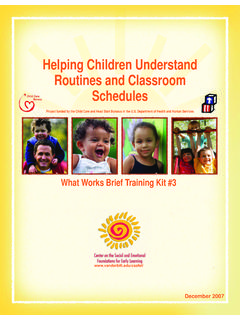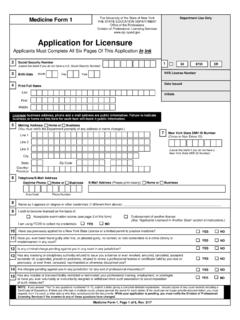Transcription of Eligibility, Recruitment, Selection, Enrollment and ...
1 ERSEA Plan January 2013 1 eligibility , recruitment , selection , Enrollment and attendance (ERSEA) Plan Philosophy It is the intent of the program to be sensitive and responsive to the specific priorities of each community and its Head Start and Early Head Start population. Program planning which includes defining recruitment , selection and Enrollment goals is based on the strengths, resources and needs of the county where a center is located. While similarities exist in these small communities, each one is unique with its own needs and strengths. These differences are incorporated in program plans and objectives. Conducting a community assessment is the beginning of the recruitment process.
2 It represents the program s organized approach to providing high quality services that are structured around community based and operated centers. The following narrative describes the steps for determining community strengths and needs as well as methods for meeting eligibility , recruitment , selection , Enrollment and attendance requirements. Determining Community Strengths and Needs: Service Area The program service area encompasses Benton, Carroll, Crockett, Dyer, Fayette, Gibson, Henry, Lake, Lauderdale, Madison, Obion, Tipton and Weakley Counties. It is critical that the program carefully observes its boundaries and does not enroll children and families from other grantees service area.
3 It is equally important that other grantees are not allowed to inadvertently or purposefully intrude upon the established and federally approved territory of Northwest Tennessee Head Start/Early Head Start. Therefore, center coordinators, family advocates and Early Head Start Teacher/Family Advocates are cautioned to carefully review addresses and physical locations of families to ensure that they actually reside in one of the program s counties. For example, portions of certain towns may lie in two different counties. It is also important to recognize the school district in which a Head Start child resides. This is necessary in order to ensure a child s eligibility for services provided by the LEA at no cost to the Head Start program, which would not be available if the child resides in another school district.
4 The community assessment will be used to determine the areas that reflect the greatest need for Head Start and Early Head Start services and the resources available to support program operation. Community Assessment A community assessment is conducted in its entirety every year. Data from the community assessment is analyzed to determine not only center locations, but appropriate selection criteria to address the demographics of the area population. ERSEA Plan January 2013 2 Age of Children and Family Income eligibility eligibility for Head Start and Early Head Start Enrollment is based on two factors: age of the child and income of the family. Children must be 3 or 4 years old on or before August 31, the date for public school eligibility in Tennessee, to receive Head Start services.
5 There are three exceptions to the three year old rule: 1) Early Head Start children can transition into Head Start when they reach their third birthday; 2) the program has approval to enroll children who become three (3) years old after August 31; 3) children with disabilities become eligible for Head Start services when they reach their third birthday. Pregnant women and infants and toddlers 0-3 years old are served in Early Head Start. Family advocates and Early Head Start Teacher/Family Advocates examine proof of age and income verification documents at the time an application is taken. The source and amount of family income is entered on each application, which is signed and dated by staff and parents.
6 Parents/guardians with no income must also sign a certification form to this effect. The application and other documents that verify income and determine the eligibility of children are kept on file at each center. A copy of these documents is submitted to the compliance office for final certification and filed by center. In all instances below poverty level families are given priority for Enrollment in Head Start and Early Head Start. Age eligible homeless children, including infants and toddlers, are also categorically eligible to participate in the program. Thirty-five percent (35%) of the program s Enrollment can come from families whose incomes are below one hundred thirty percent (130%) of the poverty line.
7 In addition, up to ten percent (10%) of funded Enrollment can be children from high-income families. Over income children who would benefit from the program and who receive selection Criteria Points include 1) children with disabilities, 2) Early Head Start children transitioning into the next placement who have become over income and 3) other children with specific and unusual needs that are identified during recruitment . recruitment of Children; Child Find and Enrollment of Children with Disabilities The community assessment is completed or reviewed annually. Data is analyzed and incorporated in program plans and procedures. Program plans and the selection criteria are presented to the Agency Board of Directors and Policy Council for approval.
8 Training for center coordinators, family advocates and Early Head Start Teacher/Family Advocates is conducted each year on changes in procedures for recruitment and selection of children. Child find activities are conducted regularly at each site. The months of February, March and April are designated for primary Child Find efforts for the coming year. At least one day is held at each center with hours set to accommodate working parents/guardians. ERSEA Plan January 2013 3 Other methods for locating potential enrollees include door-to door home visits, agency, staff and parent referrals, transfers from other programs and parents walking into centers. Methods for recruiting children with disabilities are intense and varied.
9 These include referrals from part C providers (Tennessee Early Intervention Systems), collaborations with local school systems (LEAs) and referrals from agencies, child care professionals, parents and staff and child find advertisements. While the majority of the Head Start children are identified in February, March and April, taking applications is an on-going process. Throughout the year Head Start Family Advocates and Early Head Start Teacher/Family Advocates are available to complete Enrollment applications. A ranked waiting list for each center is established and maintained to fill vacancies within 30 days unless the vacancy occurs within 60 days prior to the last classroom day.
10 In this instance the vacancy does not have to be filled. If the vacancy is filled, it should be a 3 year old child and health services must be completed within the required timeframe. A different approach is taken for Early Head Start child find. The following factors influence the identification, selection and Enrollment of Early Head Start children and families: 1) Early Head Start Enrollment is small at each center 2) few vacancies occur and 3) waiting lists far exceed funded Enrollment opportunities. selection Process The selection criteria is reviewed annually and amended if community assessment data and current waiting lists of income eligible children indicate a marked change in the conditions and circumstances of the Head Start or Early Head Start population.









